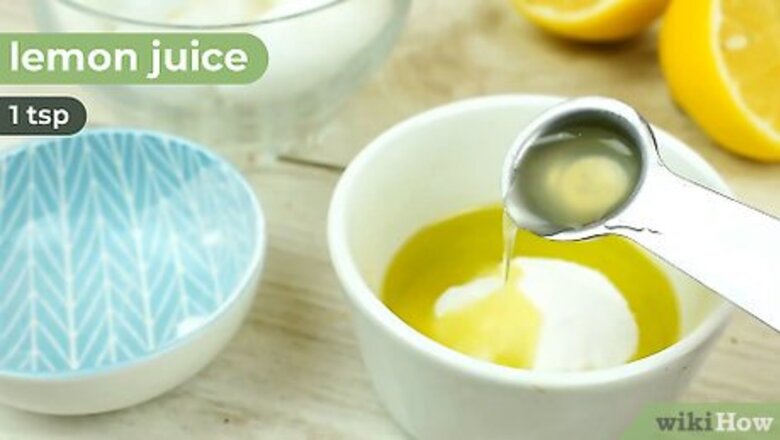
views
Removing the Polish with Baking Soda

Mix 2 parts baking soda, 1 part olive oil, and a squeeze of lemon juice in a bowl. For instance, you might use 2 tbsp (40 g) baking soda, 1 tablespoon (15 mL) olive oil and 1 teaspoon (4.9 mL) lemon juice. Then, use a spoon to stir the ingredients together thoroughly. The baking soda will probably start to fizz when you add the lemon juice. Don't worry, that's totally normal! If you want to adjust the amount of paste you're making, just keep a ratio of 2 parts baking soda to 1 part olive oil. Unless you're making a very large batch, a few squeezes of lemon juice should still be sufficient. Tip: If you don't have these ingredients on hand, try using whitening toothpaste instead!
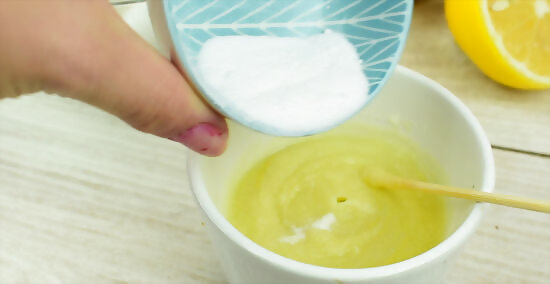
Add a little more baking soda or oil until you have a thick paste. When you first mix together the ingredients, they may seem a little too clumpy or too runny. If the mixture is too thick, drizzle in a small amount of olive oil and stir it together to loosen it. If it's too thin, sprinkle in a small amount of baking soda to thicken it up. Continue doing this until you have a thick but spreadable paste.
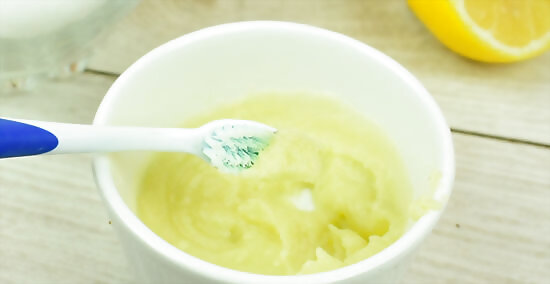
Dip a toothbrush or nail brush in the mixture. Once you've created your paste, get an old toothbrush or a stiff nail brush. Press the bristles down into the paste so they're completely coated. A new toothbrush will work too, but make sure you don't mix it up with the toothbrush you use for your teeth! The paste is made from all natural ingredients, but nail polish residue can be toxic if ingested. If the paste won't stay on the brush, it's probably too thin. Add a little more baking soda to thicken it.

Scrub your nails lightly with the brush until the stain lightens. Use the brush to work the paste onto the surface of your nail, scrubbing in a circular motion. If you need to, you can wipe the paste away to check your progress. If the stain is still there, add a little more paste and continue scrubbing. Continue until you've scrubbed all of your stained nails.
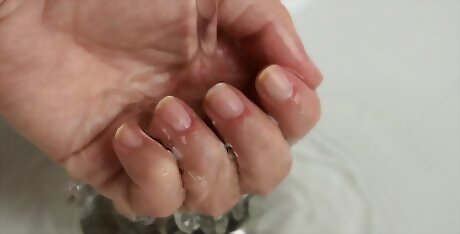
Rinse your nails with hand soap and warm water. Once you've lightened the stain as much as you can with the paste, wash your hands thoroughly with soap and water. The soap will help break up the oil in the paste, while the warm water will help dissolve the baking soda, which may leave a light residue if it has started to dry.
Soaking Your Nails in Acetone

Cut 10 pieces of foil that are big enough to wrap around your fingertips. Cut or tear 10 strips of foil that are about 4 in × 3 in (10.2 cm × 7.6 cm). The pieces should be big enough to cover your entire nail, plus a little extra, since you'll have cotton on your nail as well. Since you'll be wrapping all your nails at once, it's easiest to prepare your foil ahead of time. You may also want to set out your cotton balls at this time. If you don't want to use a whole cotton ball on each nail, cut 5 cotton balls in half, instead. Did You Know? This process is very similar to the way you remove acrylic or gel nails.
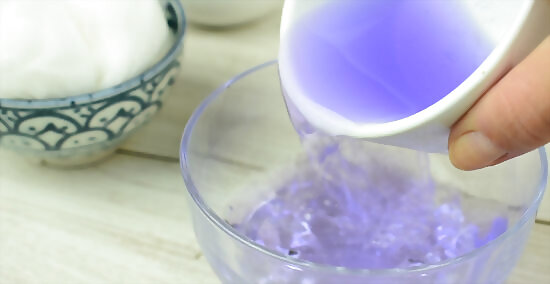
Fill a small metal or glass bowl with oil-enriched acetone. Pour about ⁄4 cup (59 mL) of the acetone into your bowl, or enough to soak all of the cotton balls. The measurement doesn't have to be precise—if you accidentally use too much, you can just pour it back into the bottle when you're finished. Do not use a plastic bowl, as the acetone will melt it. You can find oil-enriched acetone at well-stocked beauty supply stores. However, if you can't find it, you can use regular acetone, instead.
Soak a cotton ball in the acetone, then press it onto your fingernail. Dip the first cotton ball in the bowl and make sure to soak it completely. Then, place the cotton ball onto one of your fingernails, making sure to cover the surface of the nail completely. It's a good idea to cover your dominant hand first. That way, you won't have to try to use your non-dominant hand after it's covered in foil.

Wrap your nail in one of the pieces of foil. Place the center of the foil over the cotton ball, then fold the top of the foil down over the tip of your finger. Finally, wrap the sides of the foil around your fingertip to secure it. Press and squeeze the foil around your fingertip to help keep it in place.
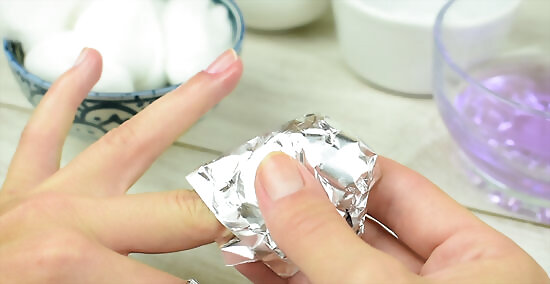
Repeat the process for all of your nails. Since you'll have to let the acetone soak in for a while, it's best to do all of your fingernails at once. Continue adding acetone-soaked cotton balls to each of your nails, and wrap each one in foil as you go. If you're concerned it will be too hard to put the foil on your other hand once your fingers are covered, you can do one hand at a time.
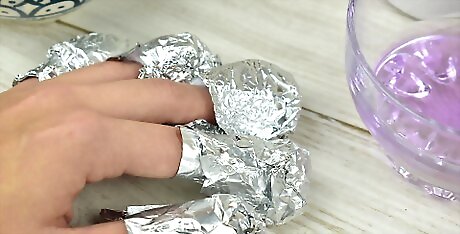
Let the acetone soak into your nails for about 10 minutes. In order to fully dissolve the stain, allow the acetone plenty of time to work. However, don't leave the acetone on longer than 10 minutes—it's a harsh chemical, and it could lead to skin irritation if you leave it on too long. While you wait, try watching TV, listening to the radio, or another fun hands-free activity so you don't get too bored!
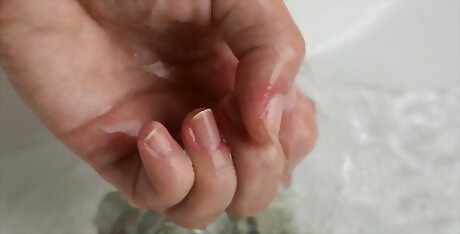
Remove the foil and cotton, then wash your hands thoroughly. After the 10 minutes, take all of the wraps off of your fingers. Wash your hands with soap and warm water, but don't scrub too hard, as your skin may be sensitive from the acetone. It may take a while for the smell of the acetone to fully fade.
Buffing the Stain
Place a drop of cuticle oil onto your nail. Cuticle oil is designed to soften the skin around your nails, but it can also help loosen nail polish stains left behind by dark or bright colors. You don't need much—one drop should be enough for each nail. If you don't have cuticle oil, try using vitamin E oil instead.
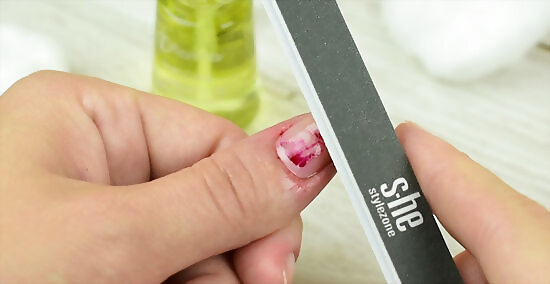
Buff your nails lightly with a buffer. Using the large-grit side of a buffer, lightly go over your nail in an X shape. Don't press down too hard, and only use about 6-8 strokes. Over-buffing your nails can damage them. You don't want to file down into the surface of your nail; you just want to scuff away the nail polish stain.
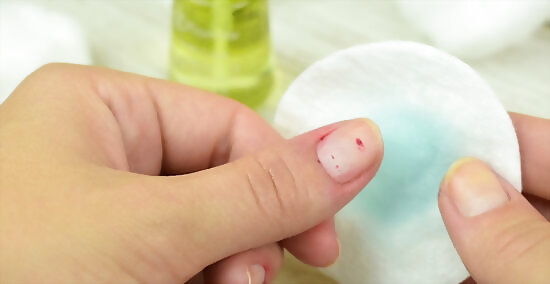
Swipe nail polish remover across your nail to remove the stain. After you've buffed your nails, the stain should be loosened. Dip a cotton ball or pad in nail polish remover, then rub it across your nail. You should see the stain lighten noticeably, and it may even go away altogether! Since buffing can damage your nail, if this doesn't work at first, consider trying another method to lighten the stain.














Comments
0 comment